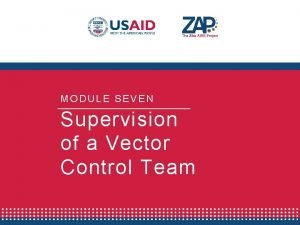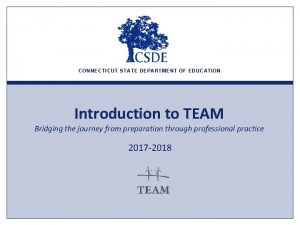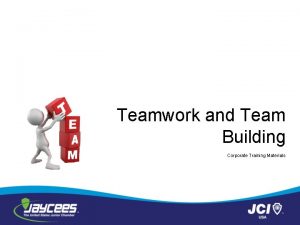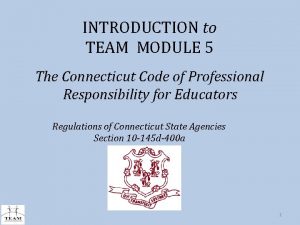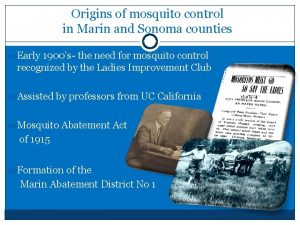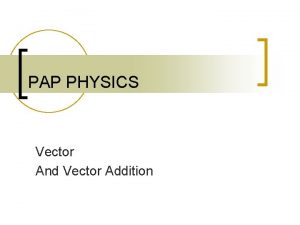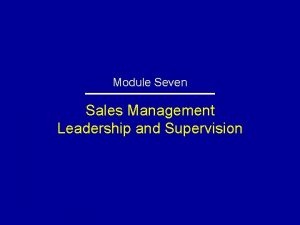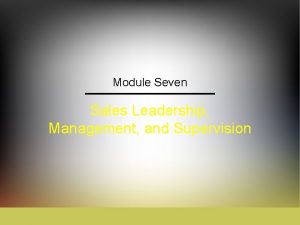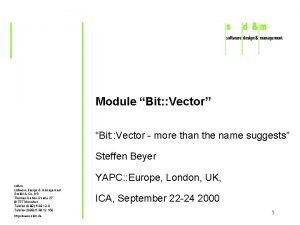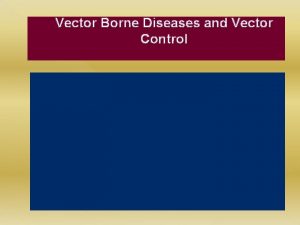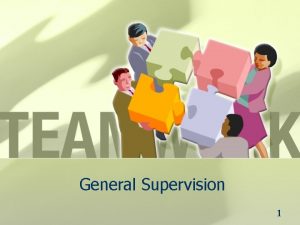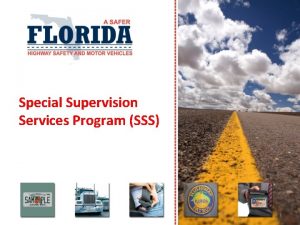MODULE SEVEN Supervision of a Vector Control Team
























- Slides: 24

MODULE SEVEN Supervision of a Vector Control Team

SUPERVISORY MANAGEMENT TOOLS AND SKILLS MODULE SEVEN

SESSION 7: OBJECTIVES Describe the responsibilities of a supervisor of vector control workforce Plan for the deployment of vector control workforce under supervision List and explain supervisory skills necessary for the success of a vector surveillance and control team List and explain a model for problem solving MODULE SEVEN

VECTOR CONTROL SUPERVISOR Planning and coordinating for deployment of the vector control workforce in communities Overseeing vector control workforce: ◦ Team members carry out vector control activities effectively, timely and accurately ◦ Team members have the skills and knowledge to carry out conduction of vector control Communicating with seasonal vector control teams MODULE SEVEN

PLANNING AND COORDINATING Planning is an important first step to make sure vector surveillance and control workers know: ◦ ◦ Where they are to work When they are to work What they are supposed to do What is the timeframe for completion MODULE SEVEN

DEPLOYMENT PLANNING CONSIDERATION MODULE SEVEN

DEPLOYMENT PLANNING CYCLE MODULE SEVEN

TIMEFRAME Is the plan monthly, weekly or daily? ◦ In areas of routine operations such as vector surveillance in sentinel sites or vector control operations in a period of no outbreak, deployment plans can be created monthly, then broken down by week and day. ◦ Non-routine operations such as urgent, needs-based vector control activities in an outbreak, weekly and daily deployment plans must be developed. MODULE SEVEN

TEAM MEMBERS How many team members are there? What are each members strengths and weaknesses? ◦ Assess the strengths and weaknesses of each member How can you pair team members so that each group is high performing and can compensate for areas of weakness? MODULE SEVEN

WORKLOAD PLANNING 1. Get road maps of each community 2. Establish information such as estimated premises count and proximity between premises 3. Divide and distribute workload across teams – allocate workload to minimize time 4. Plan out route maps to find the most efficient and cost-effective route to take to gain access to and traverse the community MODULE SEVEN

TEAM CLUSTERS Based on the number of pairs and size of community, divide the map into clusters Each pair will then be assigned a cluster MODULE SEVEN

PORTLAND MAP MODULE SEVEN

PORTLAND COMMUNITY LISTING Parish Portland Communities Cluster Vector Control Team Windsor forest Commodore Hartford Islington Kensington Rural Hill Castle Priestman’s River Boston Fair Prospect Long Bay MODULE SEVEN

SCHEDULING Create a schedule for each cluster and team: ◦ Include the most efficient route that the teams must take in order to achieve 100% coverage of the community within a specified time frame ◦ This schedule is subject to change in cases such as adverse weather conditions, security incidents, or other emergencies MODULE SEVEN

TEAM MEETINGS Hold morning team meetings for check-in: ◦ All teams know their route ◦ Check on challenges and successes ◦ Answer questions Weekly team meeting are good practice to: ◦ Set goals Assess outcomes against assigned targets Review deployment plans Issue route maps and supplies, Resolve conflict, motivate, train and empower your team MODULE SEVEN

SUPERVISORY SKILLS 1. 2. 3. 4. 5. 6. 7. Leadership Communication Conflict Resolution Interpersonal Skills Critical Thinking Time and Priority Management Problem Solving MODULE SEVEN

PROBLEM-SOLVING Identify there is a problem and Define the problem Explore possible strategies Act on best solution Look back and learn MODULE SEVEN

IDENTIFY AND DEFINE What can you see that causes you or others to think there's a problem? ◦ What can you see that causes you to think there's a problem? ◦ Where is it happening? ◦ How is it happening? ◦ When is it happening? ◦ With whom is it happening? (HINT: Don't jump to "Who is causing the problem? " When we're stressed, blaming is often one of our first reactions. To be an effective manager, you need to address issues more than people. ) ◦ Why is it happening? ACTIVITY Write down a fivesentence description of the problem: ◦ The following should be happening, but isn't. . . " or "The following is happening and should be: . . . " ◦ Be specific in your description, including what is happening, where, how, with whom and why. MODULE SEVEN

TECHNIQUE TO IDENTIFY THE ROOT CAUSE Problem: Vector Control Team is not turning in their data forms on time Why: The team does not have enough forms to complete the information Why: The team has made consistent mistakes in completing the form and throws out these forms. Does not have enough forms to fill in Why: The team does not have the knowledge to complete the form MODULE SEVEN

EXPLORE Brainstorm for solutions Select an approach to resolve the issue MODULE SEVEN

ACT ü ü What steps should be taken to implement the best alternative to solving the problem? How will you know if the steps are being followed or not? What resources will you need? How much time will you need to implement the solution? Who will be responsible? Write down the answers to the above questions and consider this as your action plan. Communicate the plan to those who will involved in implementing it and, at least, to your immediate supervisor. MODULE SEVEN

LOOK BACK MODULE SEVEN

VIDEO MODULE SEVEN

ANY QUESTIONS? ? MODULE SEVEN
 Vector control team
Vector control team Module de supervision
Module de supervision Scalar control vs vector control
Scalar control vs vector control Perbedaan pengawasan dan pengendalian mutu
Perbedaan pengawasan dan pengendalian mutu Seven heavenly virtues mal
Seven heavenly virtues mal Chickering 7 vectors
Chickering 7 vectors Vector properties
Vector properties Vector
Vector How is vector resolution the opposite of vector addition
How is vector resolution the opposite of vector addition A position vector
A position vector Seven squared football team
Seven squared football team C device module module 1
C device module module 1 Cct performance profile module 1
Cct performance profile module 1 Team building workshop modules
Team building workshop modules Ct team module
Ct team module Going native project management
Going native project management Team spirit becomes team infatuation
Team spirit becomes team infatuation The white team cheers for the blue team, just like
The white team cheers for the blue team, just like The seven quality control tools
The seven quality control tools Rule of seven control chart
Rule of seven control chart Sonoma marin vector control
Sonoma marin vector control Superior 71 flux
Superior 71 flux Ethical standards vector control
Ethical standards vector control Principle of vector control of induction motor
Principle of vector control of induction motor Quality control module
Quality control module
